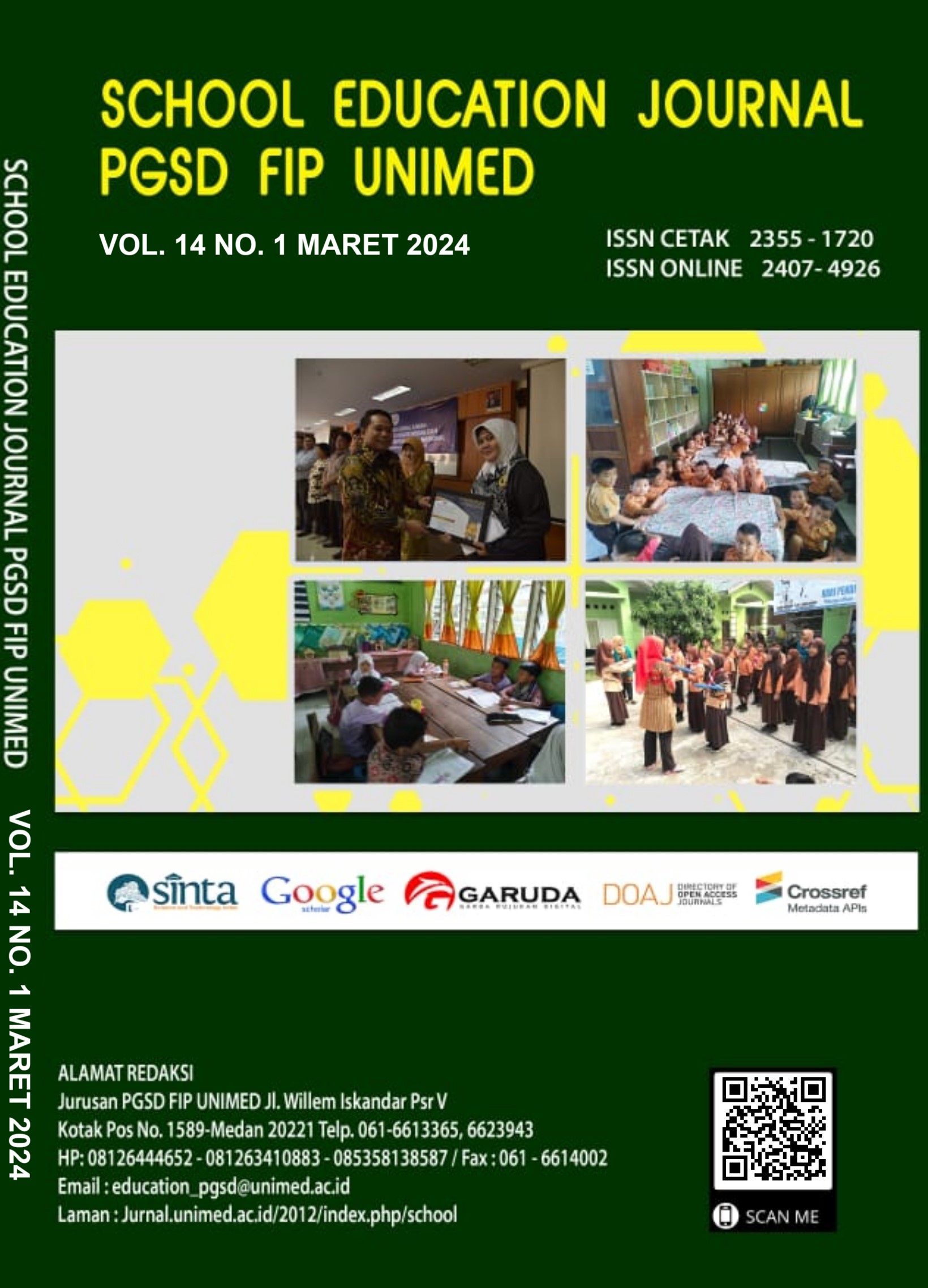MENGUAK KEKUATAN LIDIMATIKA DALAM KONTEKS PEMBELAJARAN: PENDEKATAN NEUROSCIENCE
DOI:
https://doi.org/10.24114/sejpgsd.v14i1.54768Keywords:
Mathematics Learning, Neuroscience Approach, Linguistics.Abstract
Mathematics learning aims to develop students' abilities in solving problems. Mathematics learning is expected to provide students with experience, both in solving mathematical problems and everyday life problems. This article aims to reveal the power of lidimatics, an innovation in mathematics learning using sticks with a qualitative approach using literature studies and a neuroscience approach. By analyzing the results of previous research contained in the article search engine or Google Scholar. With linguistic media, students can easily understand the concept of multiplication through direct experience, reducing the need for memorization and increasing their understanding. As an effective alternative, the linguistic multiplication method illustrates that a creative approach can help students overcome mathematical difficulties better. Through a neuroscience approach in learning mathematics, it provides deep insight into the cognitive processes involved in learning mathematics.References
Alexander, M. J., Geller, M., McLandress, C., Polavarapu, S., Preusse, P., Sassi, F., Sato, K., Eckermann, S., Ern, M., Hertzog, A., Kawatani, Y., Pulido, M., Shaw, T. A., Sigmond, M., Vincent, R., & Watanabe, S. (2010). Recent developments in gravitywave effects in climate models and the global distribution of gravitywave momentum flux from observations and models. Quarterly Journal of the Royal Meteorological Society, 136 (650), 1103“1124. https://doi.org/10.1002/qj.637
Irmayanti, D. (2014). Studi Ethnomathematics Lidimatika Dalam Konsep Perkalian Pada Siswa Kelas IV SDIT Widiya Cendikia. https://qichiegallery.blogspot.com/2014/08/studi-ethnomathematics-lidimatika-dalam_26.html
Ariani, D. N., & Supena, A. (2018). Neurosains Kognitif dalam Pembelajaran Matematika di Sekolah Dasar (Cognitive Neuroscience Of Mathematics Education In Elementary School). Jurnal THEOREMS (The Original Research of Mathematics, 3(2), 59“70. http://jurnal.unma.ac.id/index.php/th
Ati, M. T. L., Handayani, S., & Rizkasari, E. (2023). Pengaruh
Penggunaan Lidimatika terhadap Hasil Belajar Perkalian Peserta Didik Kelas IV SD Negeri Sambirejo Surakarta Tahun Ajaran 2022/2023. Jurnal Pendidikan Tambusai, 7(2), 18292“18296.
Bornemann, B., Foth, M., Horn, J., Ries, J., Warmuth, E., Wartenburger, I., & Meer, E. (2010). Mathematical cognition: individual differences in resource allocation. ZDM, 42(6), 555“567. https://doi.org/10.1007/s11858-010-0253-x
Hidayati, N., Anisah, N. K., Syarif, N. R., Shanti, W. N., & Ata, U. A. (2018). Pembelajaran Lidimatika Untuk Meningkatkan Kemampuan Siswa Sd Dalam Operasi Perkalian. Jurnal Elektronik Pembelajaran Matematika, 5(1), 55“63. http://jurnal.uns.ac.id/jpm
Kemmerer, D. (2022). Cognitive neuroscience of language. taylorfrancis.com. https://doi.org/10.4324/9781138318427
Lidinillah, D. A. M., Rahman, R., Wahyudin, W., & ... (2022). Integrating sundanese ethnomathematics into mathematics curriculum and teaching: A systematic review from 2013 to 2020. Infinity ¦. http://www.e-journal.stkipsiliwangi.ac.id/index.php/infinity/article/view/2147
Menon, V. (2010). Developmental cognitive neuroscience of arithmetic: implications for learning and education. ZDM, 42(6), 515“525. https://doi.org/10.1007/s11858-010-0242-0
Naufal, N., Kurnia, S., Khairunnisa, A., & ... (2023). Pembelajaran Operasi Perkalian Menggunakan Metode Jarimatika dan Lidimatika. Jurnal Pengabdian ¦. http://journal.amikveteran.ac.id/index.php/jpkmi/article/view/1218
Richards, B. A., Lillicrap, T. P., Beaudoin, P., Bengio, Y., & ... (2019). A deep learning framework for neuroscience. ¦ Neuroscience. https://www.nature.com/articles/s41593-019-0520-2
Rosalinda, R., & Rahmawati, F. P. (2022). Implementasi Inovasi Budaya Literasi Numerasi MACATUNG di Sekolah Dasar. Jurnal Basicedu. https://jbasic.org/index.php/basicedu/article/view/3215
Sari, A. D. I. (2023). Penggunaan Media Benda Konkret Untuk Meningkatkan Kemampuan Berhitung Materi Perkalian Siswa Kelas 3 Sekolah Dasar. Al Qodiri: Jurnal Pendidikan, Sosial Dan ¦. http://ejournal.kopertais4.or.id/tapalkuda/index.php/qodiri/article/view/5675
Smith, K. S., Bucci, D. J., Luikart, B. W., & ... (2021). DREADDS: Use and application in behavioral neuroscience. ¦ Neuroscience. https://psycnet.apa.org/record/2021-49901-001
Sukmawati, L. (2021). Analisis Literasi Numerasi Melalui Penggunaan Media Lidimatika Untuk Menyelesaikan Soal Cerita Materi Perkalian Kelas Iii Sd Negeri 1 Temon Tahun Pelajaran ¦. repository.stkippacitan.ac.id. https://repository.stkippacitan.ac.id/id/eprint/638/
Taufik, A., Yunita, & Hana, S. (2022). Optimalisasi Pendidikan Neurosains bagi Sekolah Dasar. PGMI: Jurnal Pendidikan Guru Madarasah Ibtidaiyah, 1(1), 9“19.
Zago, L., Petit, L., Mellet, E., Joliot, M., Mazoyer, B., & Tzourio-Mazoyer, N. (2010). Neural correlates of counting large numerosity. ZDM, 42(6), 569“577. https://doi.org/10.1007/s11858-010-0254-9
Downloads
Published
Issue
Section
License
Authors whose manuscripts are approved are approved as follows:
The publication rights for all journal manuscript materials published/published on the SEJ (School Education Journal) E-Journal site are held by the editorial board with the author's knowledge (moral rights remain with the manuscript authors).
The formal legal requirements for accessing this electronic digital journal article are subject to the terms of the Creative Commons Attribution-ShareAlike (CC BY) license, which means that E-Journal SEJ (School Education Journal) has the right to store, transfer media/format, manage in the form of a database, maintain, and publish articles without asking permission from the author as long as the author's name remains as the copyright owner.
Manuscripts published/published electronically are open access for educational, research, and library purposes.

